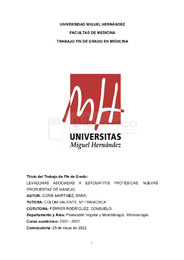Por favor, use este identificador para citar o enlazar este ítem:
https://hdl.handle.net/11000/28539Registro completo de metadatos
| Campo DC | Valor | Lengua/Idioma |
|---|---|---|
| dc.contributor.advisor | Colom Valiente, María Francisca | - |
| dc.contributor.advisor | Ferrer Rodríguez, Consuelo | - |
| dc.contributor.author | Corbí Martínez, Sara | - |
| dc.contributor.other | Departamentos de la UMH::Producción Vegetal y Microbiología | es_ES |
| dc.date.accessioned | 2022-12-01T13:46:28Z | - |
| dc.date.available | 2022-12-01T13:46:28Z | - |
| dc.date.created | 2022-05-15 | - |
| dc.identifier.uri | https://hdl.handle.net/11000/28539 | - |
| dc.description.abstract | La cavidad oral se halla colonizada por diversos microrganismos cuyo equilibrio es fundamental para evitar muchas patologías. Numerosos son los factores que pueden alterar dicho equilibrio, entre ellos, las prótesis dentales. Tal es así que, un elevado porcentaje de portadores de prótesis acaba desarrollando estomatitis protésica, proceso inflamatorio de la mucosa oral estrechamente relacionado con la infección candidiásica, especialmente con C. albicans principal especie implicada en las infecciones humanas y diana de los tratamientos convencionales empleados para resolverlas. No obstante, la literatura muestra elevadas tasas de fracaso terapéutico y recurrencia en torno a este problema. Partiendo de la hipótesis de que otras especies de Candida son las causales de la estomatitis protésica y que su sensibilidad a los distintos antifúngicos y antisépticos puede variar según el tipo, así como, por la formación de biopelículas (biofilm) que estas levaduras hacen sobre las prótesis, se ha diseñado un estudio analítico-experimental para caracterizar las especies de Candida implicadas en la estomatitis protésica de un grupo de ancianos portadores de prótesis, pacientes del Grupo Médico Dental de Elche (GMD) con quien hemos trabajado en colaboración. Además, analizar sus diferencias de sensibilidad frente a distintos antisépticos y antifúngicos de uso común permitirá establecer tratamientos más personalizados y efectivos. Para la identificación se emplearon tanto técnicas convencionales basadas en cultivo como técnicas moleculares. El estudio de sensibilidad se hizo con test en placa multipocillo y de difusión en placa de agar. Con todo lo anterior, hemos obtenido resultados que confirman nuestra hipótesis mostrando la presencia de distintas especies de Candida y diferencias en cuanto a su respuesta frente a los antimicrobianos. | es_ES |
| dc.description.abstract | The oral cavity is colonised by various microorganisms whose balance is essential to prevent many pathologies. Numerous factors can alter this balance, including dental prostheses. This is why a high percentage of prosthesis wearers end up developing prosthetic stomatitis, an inflammatory process of the oral mucosa closely related to candidal infection, especially with C. albicans, the main species involved in human infections and the target of the conventional therapies used to treat them. However, the literature shows high rates of treatment failure and recurrence around this problem. Based on the hypothesis that other Candida species are responsible for denture stomatitis and that their sensitivity to different antifungals and antiseptics may vary depending on the type, as well as the formation of biofilms that these yeasts form on the prostheses, an analytical-experimental study was designed to characterise the Candida species involved in denture stomatitis in a group of elderly prosthesis wearers, patients of the Grupo Médico Dental of Elche (GMD) with whom we have worked in collaboration. In addition, analysing their differences in sensitivity to different commonly used antiseptics and antifungals will allow us to establish more personalised and effective treatments. Both conventional culture-based and molecular techniques were used for identification. Sensitivity studies were carried out using multiwell plate and agar plate diffusion tests. With all of the above, we have obtained results that confirm our hypothesis showing the presence of different Candida species and differences in their response to antimicrobials. | es_ES |
| dc.format | application/pdf | es_ES |
| dc.format.extent | 43 | es_ES |
| dc.language.iso | spa | es_ES |
| dc.publisher | Universidad Miguel Hernández de Elche | es_ES |
| dc.rights | info:eu-repo/semantics/openAccess | es_ES |
| dc.rights.uri | http://creativecommons.org/licenses/by-nc-nd/4.0/ | * |
| dc.subject | Estomatitis protésica | es_ES |
| dc.subject | Candidiasis protésica | es_ES |
| dc.subject | C. Albicans | es_ES |
| dc.subject | Protésis dental | es_ES |
| dc.subject | Biopelículas | es_ES |
| dc.subject | Antifúngicos | es_ES |
| dc.subject | Antisépticos | es_ES |
| dc.subject.other | CDU::6 - Ciencias aplicadas::61 - Medicina | es_ES |
| dc.title | Levaduras asociadas a estomatitis protésicas: Nuevas propuestas de manejo | es_ES |
| dc.type | info:eu-repo/semantics/bachelorThesis | es_ES |

Ver/Abrir:
CORBÍ MARTÍNEZ, SARA, TFG .pdf
5,34 MB
Adobe PDF
Compartir:
 La licencia se describe como: Atribución-NonComercial-NoDerivada 4.0 Internacional.
La licencia se describe como: Atribución-NonComercial-NoDerivada 4.0 Internacional.
.png)